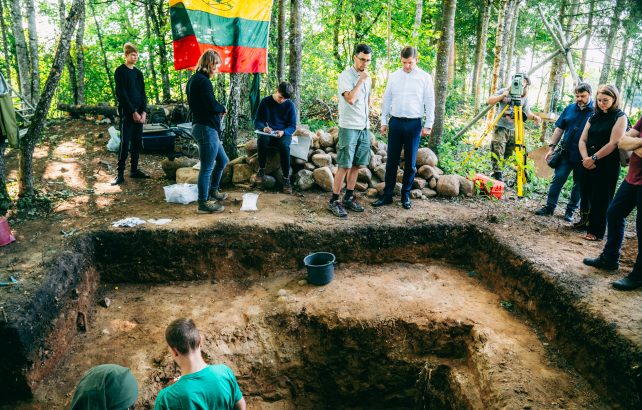A PhD Student From the VU Faculty of History on the Unique Discovery of a Partisan Command Post
 Archaeologists from Klaipėda University, led by Dr Gediminas Petrauskas, have recently unearthed a partisan headquarters in the Telšiai District, near the village of Kuršai. In this article, Enrika Kripienė, a doctoral student at the Faculty of History of Vilnius University (VU) and historian at the Genocide and Resistance Research Centre of Lithuania, discusses the importance of this discovery and other research on partisan bunkers.
Archaeologists from Klaipėda University, led by Dr Gediminas Petrauskas, have recently unearthed a partisan headquarters in the Telšiai District, near the village of Kuršai. In this article, Enrika Kripienė, a doctoral student at the Faculty of History of Vilnius University (VU) and historian at the Genocide and Resistance Research Centre of Lithuania, discusses the importance of this discovery and other research on partisan bunkers.
The scholar describes the latest finding by researchers from Klaipėda University as unique. In the Telšiai District, the archaeologists have unearthed a bunker of the prominent partisan Povilas Bagdonas, who acted together with the Commander of the Samogitian District – Vladas Montvydas-Žemaitis; later, Bagdonas himself became the last commander of the Šatrija partisan territorial unit.
"The bunker was found in pristine condition, i.e. undamaged and intact. In the late 1940s, when the armed resistance in Lithuania reached its maturity, the freedom fighters hiding there learnt they were being tracked, so they left the bunker with only their most essential possessions. Press reports reveal that the bunker was primarily equipped with household items used by partisans, including perfume bottles, empty medicine ampoules, buttons, and belt buckles. Over 300 artefacts have been found, shedding light on the daily life of those involved in the armed resistance. These items will also prompt new questions for researchers and perhaps even help them uncover some answers and take a glimpse into partisans’ day-to-day living experience," says the doctoral student.
"Most of us intuitively understand that their daily routine (and existence in general) must have been very challenging both physically and psychologically: imagine several people crammed into a confined space of about six square metres (also the size of the newly discovered command post) with insufficient headroom and restricted airflow. The conducted research has only confirmed this perception, and the archaeological findings perfectly illustrate the harsh living conditions, adding a layer of reality," says Enrika Kripienė, reflecting on the difficulties faced by partisans.
The historian adds that this partisan bunker is remarkably well-equipped compared to the vast majority of the other known ones. The partisans managed to generate electricity in this headquarters, sourced from a nearby mill. Moreover, the bunker was located next to a farmer’s bathhouse and had stones resting atop the log ceiling so that the repressive structures’ agents could not detect anything suspicious during their usual surveillance of the surrounding area.
"Here’s how Povilas Bagdonas himself saw the building and enhancement of partisan bunkers: I have constructed bunkers under diverse conditions. /.../ and built a whole load of them. Later, I earned the title of bunker master. Initially, we used to make very primitive ones. They [the extermination battalions] would hunt for us in a foolish way, while we would build shelters just as foolishly. However, lately, their techniques have advanced to the point where they can now find us in such places. We had to change our tactics, so we did. The impressively disguised bunker and its electrical installation suggest that it may have been used by the highest leadership of Samogitian partisans at the time," considers the scholar.
When asked about the scope and nature of such research, Enrika Kripienė points out that the concept of partisan bunkers is deeply intertwined with the collective memory of the country’s struggle for freedom.
"It is very interesting and somewhat surprising that we have only nine bunkers professionally excavated and investigated since the restoration of Lithuania’s independence. In general, such scientific archaeological research in Lithuania started relatively recently: the first works in Minaičiai and Balandiškis began only in 2010. Symbolically, the first research of this kind was devoted to the bunkers used during the meeting of the Lithuanian partisan commanders in early 1949 and later by the representatives of the supreme central authority of freedom fighters. I believe it is reasonable to assert that these bunkers hold distinctive significance in the history of our statehood and political thought," adds the VU researcher.
According to the historian, each partisan bunker is important and unique in its own way, so professional and in-depth exploration of them can unveil the narrative of the independence movement for both scholars and anyone interested in this topic: "By skilfully applying the gathered information and selecting a suitable format, the testimony of the bunker can enrich the overall historical picture of the armed resistance with new brushstrokes and shades of authentic meaning."